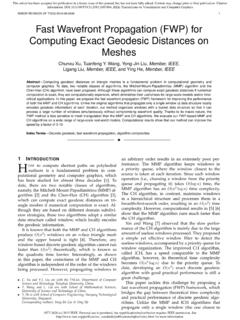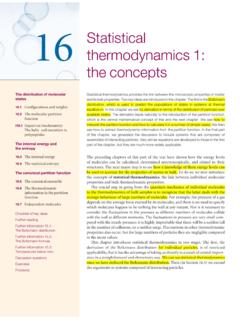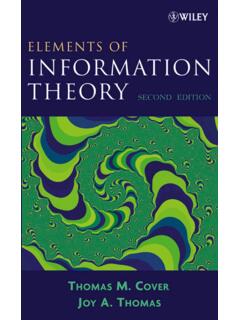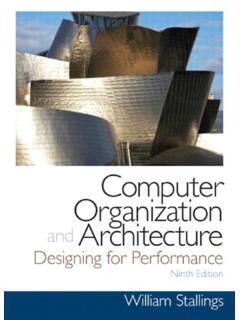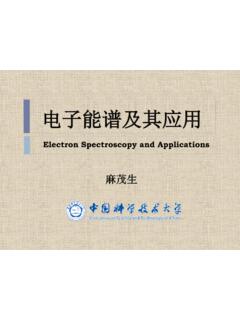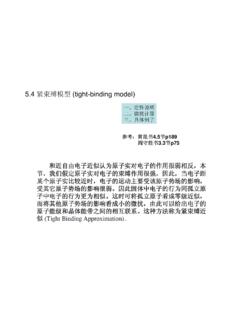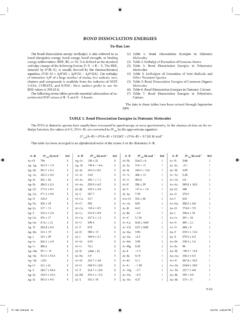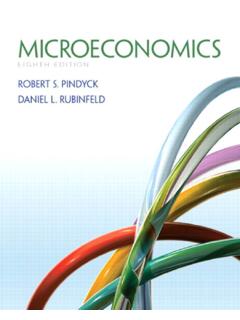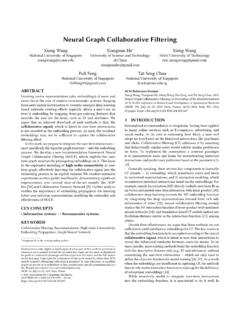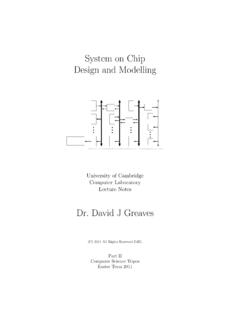Transcription of IEEE Standard for Verilog Hardware Description Language
1 IEEE Std 1364 -2005(Revision of IEEE Std 1364-2001)IEEE Standard for Verilog Hardware Description LanguageI E E E3 Park Avenue New York, NY10016-5997, USA7 April 2006 IEEE Computer SocietySponsored by theDesign Automation Standards CommitteeAuthorized licensed use limited to: University of Science and Technology of China. Downloaded on September 20,2012 at 02:33:32 UTC from IEEE Xplore. Restrictions apply. Authorized licensed use limited to: University of Science and Technology of China. Downloaded on September 20,2012 at 02:33:32 UTC from IEEE Xplore. Restrictions apply. The Institute of Electrical and Electronics Engineers, Park Avenue, New York, NY 10016-5997, USAC opyright 2006 by the Institute of Electrical and Electronics Engineers, rights reserved. Published 7 April 2006. Printed in the United States of is a registered trademark in the Patent & Trademark Office, owned by the Institute of Electrical and ElectronicsEngineers, is a registered trademark of Cadence Design Systems, : ISBN 0-7381-4850-4 SH95395 PDF: ISBN 0-7381-4851-2 SS95395No part of this publication may be reproduced in any form, in an electronic retrieval system or otherwise, without the priorwritten permission of the Std 1364 -2005(Revision of IEEE Std 1364-2001)IEEE Standard for Verilog Hardware Description LanguageSponsorDesign Automation Standards Committeeof theIEEE Computer SocietyAbstract: The Verilog Hardware Description Language (HDL) is defined in this Standard .
2 VerilogHDL is a formal notation intended for use in all phases of the creation of electronic systems. Be-cause it is both machine-readable and human-readable, it supports the development, verification,synthesis, and testing of Hardware designs; the communication of Hardware design data; and themaintenance, modification, and procurement of Hardware . The primary audiences for this standardare the implementors of tools supporting the Language and advanced users of the : computer, computer languages, digital systems, electronic systems, Hardware , hard-ware Description languages, Hardware design, HDL, PLI, programming Language interface, Verilog , Verilog HDL, Verilog PLIA uthorized licensed use limited to: University of Science and Technology of China. Downloaded on September 20,2012 at 02:33:32 UTC from IEEE Xplore. Restrictions apply. IEEE Standards documents are developed within the IEEE Societies and the Standards CoordinatingCommittees of the IEEE Standards Association (IEEE-SA) Standards Board.
3 The IEEE develops its standardsthrough a consensus development process, approved by the American National Standards Institute, which bringstogether volunteers representing varied viewpoints and interests to achieve the final product. Volunteers are notnecessarily members of the Institute and serve without compensation. While the IEEE administers the processand establishes rules to promote fairness in the consensus development process, the IEEE does not independentlyevaluate, test, or verify the accuracy of any of the information contained in its of an IEEE Standard is wholly voluntary. The IEEE disclaims liability for any personal injury, property orother damage, of any nature whatsoever, whether special, indirect, consequential, or compensatory, directly orindirectly resulting from the publication, use of, or reliance upon this, or any other IEEE Standard IEEE does not warrant or represent the accuracy or content of the material contained herein, and expresslydisclaims any express or implied warranty, including any implied warranty of merchantability or fitness for a spe-cific purpose, or that the use of the material contained herein is free from patent infringement.
4 IEEE Standardsdocuments are supplied AS IS. The existence of an IEEE Standard does not imply that there are no other ways to produce, test, measure,purchase, market, or provide other goods and services related to the scope of the IEEE Standard . Furthermore, theviewpoint expressed at the time a Standard is approved and issued is subject to change brought about throughdevelopments in the state of the art and comments received from users of the Standard . Every IEEE Standard issubjected to review at least every five years for revision or reaffirmation. When a document is more than fiveyears old and has not been reaffirmed, it is reasonable to conclude that its contents, although still of some value,do not wholly reflect the present state of the art. Users are cautioned to check to determine that they have thelatest edition of any IEEE publishing and making this document available, the IEEE is not suggesting or rendering professional or otherservices for, or on behalf of, any person or entity.
5 Nor is the IEEE undertaking to perform any duty owed by anyother person or entity to another. Any person utilizing this, and any other IEEE Standards document, should relyupon the advice of a competent professional in determining the exercise of reasonable care in any : Occasionally questions may arise regarding the meaning of portions of standards as they relate tospecific applications. When the need for interpretations is brought to the attention of IEEE, the Institute will initiateaction to prepare appropriate responses. Since IEEE Standards represent a consensus of concerned interests, it isimportant to ensure that any interpretation has also received the concurrence of a balance of interests. For thisreason, IEEE and the members of its societies and Standards Coordinating Committees are not able to provide aninstant response to interpretation requests except in those cases where the matter has previously received formalconsideration.
6 At lectures, symposia, seminars, or educational courses, an individual presenting information onIEEE standards shall make it clear that his or her views should be considered the personal views of that individualrather than the formal position, explanation, or interpretation of the IEEE. Comments for revision of IEEE Standards are welcome from any interested party, regardless of membership affil-iation with IEEE. Suggestions for changes in documents should be in the form of a proposed change of text,together with appropriate supporting comments. Comments on standards and requests for interpretations shouldbe addressed to:Secretary, IEEE-SA Standards Board445 Hoes LanePiscataway, NJ 08854 USAA uthorization to photocopy portions of any individual Standard for internal or personal use is granted by the Insti-tute of Electrical and Electronics Engineers, Inc., provided that the appropriate fee is paid to Copyright ClearanceCenter.
7 To arrange for payment of licensing fee, please contact Copyright Clearance Center, Customer Service,222 Rosewood Drive, Danvers, MA 01923 USA; +1 978 750 8400. Permission to photocopy portions of any indi-vidual Standard for educational classroom use can also be obtained through the Copyright Clearance Attention is called to the possibility that implementation of this Standard may require use of subjectmatter covered by patent rights. By publication of this Standard , no position is taken with respect to theexistence or validity of any patent rights in connection therewith. The IEEE shall not be responsible foridentifying patents for which a license may be required by an IEEE Standard or for conducting inquiries into thelegal validity or scope of those patents that are brought to its licensed use limited to: University of Science and Technology of China.
8 Downloaded on September 20,2012 at 02:33:32 UTC from IEEE Xplore. Restrictions apply. Copyright 2006 IEEE. All rights Verilog Hardware Description Language (HDL) became an IEEE Standard in 1995 as IEEE Std 1364-1995. It was designed to be simple, intuitive, and effective at multiple levels of abstraction in a standardtextual format for a variety of design tools, including verification simulation, timing analysis, test analysis,and synthesis. It is because of these rich features that Verilog has been accepted to be the Language of choiceby an overwhelming number of integrated circuit (IC) contains a rich set of built-in primitives, including logic gates, user-definable primitives, switches,and wired logic. It also has device pin-to-pin delays and timing checks. The mixing of abstract levels isessentially provided by the semantics of two data types: nets and variables.
9 Continuous assignments, inwhich expressions of both variables and nets can continuously drive values onto nets, provide the basicstructural construct. Procedural assignments, in which the results of calculations involving variable and netvalues can be stored into variables, provide the basic behavioral construct. A design consists of a set of mod-ules, each of which has an input/output (I/O) interface, and a Description of its function, which can be struc-tural, behavioral, or a mix. These modules are formed into a hierarchy and are interconnected with Verilog Language is extensible via the programming Language interface (PLI) and the Verilog proce-dural interface (VPI) routines. The PLI/VPI is a collection of routines that allows foreign functions to accessinformation contained in a Verilog HDL Description of the design and facilitates dynamic interaction withsimulation.
10 Applications of PLI/VPI include connecting to a Verilog HDL simulator with other simulationand computer-assisted design (CAD) systems, customized debugging tasks, delay calculators, Language that influenced Verilog HDL the most was HILO-2, which was developed at Brunel Univer-sity in England under a contract to produce a test generation system for the British Ministry of successfully combined the gate and register transfer levels of abstraction and supported verificationsimulation, timing analysis, fault simulation, and test 1990, Cadence Design Systems placed the Verilog HDL into the public domain and the independentOpen Verilog International (OVI) was formed to manage and promote Verilog HDL. In 1992, the Board ofDirectors of OVI began an effort to establish Verilog HDL as an IEEE Standard . In 1993, the first IEEE working group was formed; and after 18 months of focused efforts, Verilog became an IEEE Standard asIEEE Std 1364-1995.
